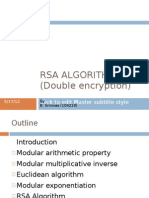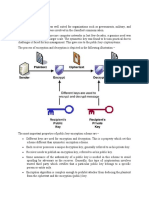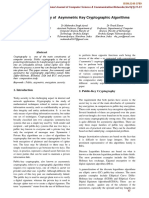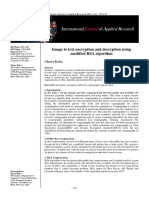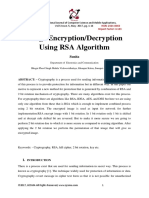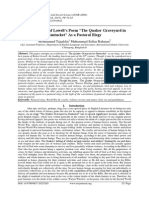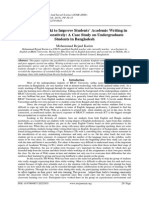Improvised Asymmetric Key Encryption Algorithm Using MATLAB
Uploaded by
IOSRjournalImprovised Asymmetric Key Encryption Algorithm Using MATLAB
Uploaded by
IOSRjournalIOSR Journal of Electronics and Communication Engineering (IOSR-JECE)
e-ISSN: 2278-2834,p- ISSN: 2278-8735.Volume 10, Issue 2, Ver. IV (Mar - Apr.2015), PP 31-36
www.iosrjournals.org
Improvised Asymmetric Key Encryption Algorithm Using
MATLAB
K.Sony1, Desowja Shaik1, B.Divya Sri2, G.Anitha3
1
Assistant Professor, K L University, Vaddeswaram, Guntur District, AP
ECE Department, K L University, Vaddeswaram, Guntur District, AP
2,3, 4
Abstract: In this paper, A new technique is deployed to improve Asymmetric Key Encryption Technique with
multiple keys and Chinese remainder theorem(CRT) .The main aim of this Technique is to provide secure
transmission of data between any networks through a channel. The Scope of this paper deals with Multiple
Public and Private keys and its computation time. RSA algorithm is used to utilize asymmetric key encryption
technique .In proposed model RSA will be implemented using MATLAB with original RSA Algorithm
,Proposed RSA Algorithm and RSA using Chinese Remainder Theorem(CRT). The Computational time and its
mere effects are briefly dealt by varying the multiple number of keys .
Keywords: RSA, Multiple key, Chinese Remainder Theorem (CRT), Secure, MATLAB.
I.
Introduction
In Communications regardless of the platform such as email, Voice messages or direct messages the
end users ultimate motive is to send or receive the information without any intervention from the intruder. So a
mechanism is to be deployed such that only the users should understand the information and for others it should
be in the unreadable format .The process of encoding the plain text messages into cipher text is referred as
Encryption and the reverse transforming process is decryption. In a Computer to Computer communications, the
sender usually does the encryption and at the receiving end the decryption is done[1] .
Every encryption and decryption process has two primarily goals : Algorithm and the key generation .
Algorithm is made public to all the users an its the key which makes the communication secure
between the user domain. If the same key is used at both the ends then it is referred as Symmetric Key
Cryptography and if different keys(Public and private key ) are used at both the ends its Asymmetric key
Cryptography[16]. The above mentioned process is depicted in the figure.
In this paper we deal about the Asymmetric key cryptography[3] since it overcomes the disadvantages
of symmetric key cryptography such as key exchange and also digital signature can be deployed using this
technique .It also deals about doing the encryption and decryption using two keys at both the ends so that the
information can be sent more securely using the Modified RSA Algorithm and with Chinese Remainder
Theorem .
II.
RSA Crypto System
The RSA Algorithm was developed by Ron Rivest, Adi Shamir and Leonard in 1978[17]. The original
RSA algorithm follows 4 phases: Key Generation, Encryption, Decryption and Digital signature [9].
DOI: 10.9790/2834-10243136
www.iosrjournals.org
31 | Page
Improvised Asymmetric Key Encryption Algorithm Using MATLAB
Keygeneration
In key generation we typically need keys that are public and private keys. We will generate public and
private key using below steps [2]. Public key is visible to both sender and receiver, where as private key is kept
secret and is generated and made invisible to the end user. Public key is used during encryption process where
as private key is used during decryption process. The steps to find out public and private key in key generation
is given below.
1). Select two random prime numbers: r, s and find n=r*s.
2). Compute the value of (n)=(r-1)*(s-1)
3). Select a random integer e[12], such that 1<e<n and gcd(e, (n))=1.
4). Compute value of d, such that d*e 1 mod(n).
5). Public Key {e, n}, Private key {d, n}
Encryption
We generated public and private keys using Key generation. Now, we have to encrypt the message
using Public key. The process is dealt as given below
1). Take the message which represents Plain text. The Plain text should be encrypted using public key e. If a
sender wants to transmit the information to receiver, the receiver should send the public key to the sender ,and
then the sender will encrypt the message(M) with a Public key(e).
2). Now calculate the cipher text (C) by using given formula.
C=M ^ e mod(n)
Decryption
In decryption we will find out decrypted message(M) by using cipher text(C) and Private key(d).Then Compare
if the original message is equal to decrypted message[5]. If it is equal then algorithm is proven .
M=C ^ d mod(n)
Digital Signature
In order to find whether the process we followed in designing the algorithm is accurate or not we use
the concept of digital signature[6]. Here we will find signature(s) using private key(d) and H(m). And we will
find verification m using signature(s) and public key(e) where H is the hash function. If m=H(m) then our
signature is correct[7]. The following formula are given below:
s = (H(m)^d)mod n
m=(s^ e) mod n.
.
2.1 Modified RSA Algorithm Using Multiple Keys
Here in Modified RSA algorithm we will generate multiple public and private keys. In modified RSA
algorithm the computational time is more due to multiple keys but security is more compared to original RSA
algorithm[10]. In modified RSA algorithm we are using two public and private keys it is less subjected to brute
force attack. Here in this we are having 3 phases are: key generation, encryption, decryption[14].
Key Generation In Modified RSA Algorithm
In key generation process we will generate multiple public and private keys using below steps. Here in
order to increase security we are generating multiple keys. Here public keys are visible to both sender and
receiver. And private keys are kept secret and. The following steps for key generation process in given below:
1). Select two set random numbers say p, q and r, s.
2). Find the value of n, z i.e., n=p*q, z=r*s
3). Compute the value of (n)=(p-1)*(q-1), k(z)=(p-1)*(q-1).
4). Select a random integer e, g such that 1<e<n, 1<g<z and gcd(e, (n))=1gcd(e, k(z))=1
5). Compute value of d, T such that d*e 1 mod(n) and t*g 1 mod(z)
6). Public Key {e, g, n, z}, Private key {d, t, n, z}
Encryption
We have generated multiple public and private key in above key generation. Now we will encrypt
using public keys. Since we will do two times encryption such a way reliability will be more compared to that
DOI: 10.9790/2834-10243136
www.iosrjournals.org
32 | Page
Improvised Asymmetric Key Encryption Algorithm Using MATLAB
of original RSA algorithm. We take message(M) and first public key(e) during encryption and find out C1=M^
e mod(n). By using c1 and second public key(g) we will find cipher text in encryption process.
C=C1^ g mod(z)
Decryption
In decryption we decrypt original message using private keys d, g. Here first we will decrypt using first
private key (d) which is m1=C ^ d mod(n).
And we will find out decrypted message using second private key (t).
M=m1 ^ t mod(z)
2.3 RSA Algorithm Using Chinese Remainder Theorem
By using Chinese remainder theorem(CRT)[4] we will increase processing time and security of
algorithm. By using CRT an efficient implementation of RSA algorithm can be implemented. Chinese
remainder theorem(CRT) states that, if input M, raise it to the eth (or dth) power modulo P and modulo Q the
intermediate results are then combined through multiplication and addition with some pre defined constant to
compute final result. By using CRT in RSA algorithm it requires four times less processing time compared and
smaller amount of memory for final decoded result. By Using Multi Prime Concept[19] we implement RSA
using CRT. They are 3 operations present in RSA using CRT are:
Key Generation Operation
The steps included in the key generation operation of multi-prime RSA-CRT are illustrated as:
i. Select three large prime r, s and w at random, each of which is n/3-bit in length.
ii. Set N = r x s x w and (N) = (r1) x (s1) x (w1).
iii. Randomly pick an odd integer e such that gcd (e, (N)) = 1.
iv. After that compute d = e1 mod (N).
v. Finally, calculate dr = d mod (r 1), ds = d mod (s 1) and dw = d mod (w 1).
vi. The public key would be (e, N) and the private key would be (dr, ds, dw, r, s, w)[20].
Encryption Operation
For a given plain text m which belongs to Zn the encryption algorithm is the same as that of the original RSA:
c = m^ e mod N
Decryption Operation
In order to decrypt a cipher-text c:
i. The decipher first computes m1 =cr^ dr mod r, m2 = cs^ dq mod s, and m3 = cw^ dw mod w where cr = c
mod r, cs = c mod s and cw = c mod w
ii. Next, using CRT m can be obtained as m = c^ d mod N, in order to increase its efficiency.
III.
Implementation And Results
3.1Original RSA Algorithm Implemented Using Alphabetic Message and Numerical Message
DOI: 10.9790/2834-10243136
www.iosrjournals.org
33 | Page
Improvised Asymmetric Key Encryption Algorithm Using MATLAB
3.2Modified RSA Algorithm Using Multiple Public and Private Keys
DOI: 10.9790/2834-10243136
www.iosrjournals.org
34 | Page
Improvised Asymmetric Key Encryption Algorithm Using MATLAB
3.3
RSA Algorithm Using Chinese Remainder Theorem(CRT)
IV.
Graphs
Computation Time V/s Prime numbers
V.
Conclusion
The observed results from our work clearly mention that by using a single (public and private key)the
computational time required is less but problem is less secure. To have more secured transmission of
information we can use Chinese remainder theorem so that there will be reduction of time of evaluation. So to
have both secure transmission and time bound application we can use two key methods.
Acknowledgements
Authors like to express their deep gratitude to K Sony, Assistant Professor Department of ECE K L
University for her great support and encouragement during the implementation of this work and also we would
also like to thank our communications research members and also our friends for their help in completion of this
paper.
References
[1].
[2].
[3].
[4].
William Stallings, Cryptography and Network Security, ISBN 81-7758-011-6, Pearson Education, Third Edition
R.L.Rivest,A. Shamir, and L.Adleman, A method for obtaining digital signature and public key cryptosystem,
comm..ACM feb1978, 21(2):120-126
W.Diffie and M.E.Hellman, New directions in cryptography, IEEE Trans. Inform. Theory, Nov.1976,22: 644-654.
DOI: 10.9790/2834-10243136
www.iosrjournals.org
35 | Page
Improvised Asymmetric Key Encryption Algorithm Using MATLAB
[5].
[6].
[7].
[8].
[9].
[10].
[11].
[12].
[13].
[14].
[15].
[16].
[17].
[18].
[19].
[20].
[21].
Chung-Hsien Wu; Jin-Hua Hong; Cheng-Wen Wu, "RSA cryptosystem design based on the Chinese remainder theorem," Design
Automation Conference, 2001. Proceedings of the ASP-DAC 2001. Asia and South Pacific , vol., no., pp.391,395, 2001
H. Ren-Junn, S. Feng-Fu, Y. Yi-Shiung and C. Chia-Yao An efficient decryption method for RSA cryptosystem Advanced
Information Networking and Applications, 2005 (AINA 2005). 19th International Conference on, 2005, pp. 585 -590 vol.1.
Z. Shao. Security of a new digital signature scheme based on factoring and discrete logarithms. International Journal of Computer
Mathematics, 82(10):1215-1219,2005.
D. Poulakis. A variant of Digital Signature Algorithm. Designs, Codes and Cryptography, 51(1):99-104, 2009
C. Kaufman, R. Perlman, M. Speciner, Network security, Prentice Hall 1995
Ronald L. Rivest, Adi Shamir, Len Adelman, "On Digital Signatures and Public Key Cryptosystems," MIT Laboratory for
Computer Science Technical Memorandum82 (April 1977).
Behrouz A. Forouzen, Cryptography and Network Security, Tata McGraw-Hill Publishing Company Ltd, New Delhi, ISBN-13:
987-0-07-066046-5, 2010.
http://www.rsa.com/rsalabs/node.asp?id=2167
Niven, I., and Zuckerman, H.S. An Introduction to the Theory of Numbers. Wile , New York, 1972.
http://www.scribd.com/doc/55154238/31/DISADVANTAGES-OF-RSA
Atul Kahate Cryptography and Network Security 3rd edition.
Gagandeep shahi Charanjit Singh Cryptography and its Implementation Approaches International Journal of Innovative Research
in Computer and communication Engineering, Vol.1,Issue 3,May 2013,PP 668-672
M. Bellare and P. Rogaway. Optimal Asymmetric Encryption. In A. De Santis, ed., Proceedings of Eurocrypt 1994, vol. 950 of
LNCS, pp.92-111. Spinger-Verlag, May 1994
http://en.wikipedia.org/wiki/RSA
M. Wiener. Cryptanalysis of Short RSA Secret Exponents. IEEE Transactions on Information Theory, Vol. 36, No. 3, pp,553558, 1990
M.J.Hinek, M.K.Low, and E.Teske. On some attacks on multi prime RSA. In K.Nyberg and H.M.Heys, editors, Selected areas in
Cryptography, volume 2595 of Lecture Notes in Computer Science ,pages 385-404. Springer, 2002.
N. Ojha and S. Padhye," Cryptanalysis of Multi Prime RSA with Secret Key Greater than Public Key", International Journal of
Network Security, Vol.16, No.1, PP.53-57, Jan, 2014
Authors Profile
K.SONY is Assistant Professor in KL University. She Completed M.Tech Electronics and Communication
Engineering from ANNA University. He is getting his specialization in Signal processing
applications.. He is member of IETE. Her interest in research areas includes Optical
Communication and Image processing applications
DESOWJA SHAIK was born in India, A.P, in 1994.He is pursuing her B.Tech in Electronics and
Communication Engineering from K L University. He is getting his specialization in
communication. He presented 3 papers in International technical fests at reputed engineering
colleges. He is member of IETE. His interest in research areas includes Networking and
Cryptography and Communication.
B.DIVYA SRI was born in India, A.P, in 1994. She is pursuing her B.Tech in Electronics and Communication
Engineering from K L University. She is getting her specialization in communication. She is
member of IETE. Her interest in research includes VLSI and Image processing.
G.ANITHA was born in India, A.P, in 1994. She is pursuing her B.Tech in Electronics and Communication
Engineering from K L University. She is getting her specialization in communication. She is
member of IETE. Her interest in research includes Antennas and Networking.
DOI: 10.9790/2834-10243136
www.iosrjournals.org
36 | Page
You might also like
- Information Systems Security LAB: RSA Cryptography AlgorithmNo ratings yetInformation Systems Security LAB: RSA Cryptography Algorithm9 pages
- Rabin Cryptography and Implementation Using C Programming LanguageNo ratings yetRabin Cryptography and Implementation Using C Programming Language19 pages
- Public-Key Cryptography and Message AuthenticationNo ratings yetPublic-Key Cryptography and Message Authentication20 pages
- Implementation of RSA Algorithm With Chinese Remainder Theorem For Modulus N 1024 Bit and 4096 BitNo ratings yetImplementation of RSA Algorithm With Chinese Remainder Theorem For Modulus N 1024 Bit and 4096 Bit9 pages
- Comparative Study of Asymmetric Key Cryptographic Algorithms100% (1)Comparative Study of Asymmetric Key Cryptographic Algorithms5 pages
- Image To Text Encryption and Decryption Using Modified RSA AlgorithmNo ratings yetImage To Text Encryption and Decryption Using Modified RSA Algorithm5 pages
- Public Key Cryptosystems With ApplicationsNo ratings yetPublic Key Cryptosystems With Applications21 pages
- IRJET Comparative Analysis of RSA and ECNo ratings yetIRJET Comparative Analysis of RSA and EC6 pages
- Image Encryption/Decryption Using RSA Algorithm: SunitaNo ratings yetImage Encryption/Decryption Using RSA Algorithm: Sunita14 pages
- Enhanced Rsa Cryptosystem Based On Three Prime Numbers: Vivek Choudhary and Mr. N. Praveen100% (1)Enhanced Rsa Cryptosystem Based On Three Prime Numbers: Vivek Choudhary and Mr. N. Praveen5 pages
- CSPC-307 RSA and Public Key Cryptography September 2023No ratings yetCSPC-307 RSA and Public Key Cryptography September 202337 pages
- A Survey On Cryptography Comparative Study Between RSA Vs ECC Algorithms and RSA Vs El-Gamal AlgorithmsNo ratings yetA Survey On Cryptography Comparative Study Between RSA Vs ECC Algorithms and RSA Vs El-Gamal Algorithms4 pages
- FPGA Implementation of RSA Encryption System: Sushanta Kumar Sahu Manoranjan PradhanNo ratings yetFPGA Implementation of RSA Encryption System: Sushanta Kumar Sahu Manoranjan Pradhan3 pages
- Experiment: 1 Euclidean and Extended Euclidean AlgorithmNo ratings yetExperiment: 1 Euclidean and Extended Euclidean Algorithm23 pages
- Blockchain_Practicals_Reference Journal.docxNo ratings yetBlockchain_Practicals_Reference Journal.docx146 pages
- A Comparison Between Encryption and Decryption'No ratings yetA Comparison Between Encryption and Decryption'15 pages
- Transformation of Cryptography: Fundamental concepts of Encryption, Milestones, Mega-Trends and sustainable Change in regard to Secret Communications and its NomenclaturaFrom EverandTransformation of Cryptography: Fundamental concepts of Encryption, Milestones, Mega-Trends and sustainable Change in regard to Secret Communications and its NomenclaturaNo ratings yet
- Cryptography Basics for New Coders: A Practical Guide with ExamplesFrom EverandCryptography Basics for New Coders: A Practical Guide with ExamplesNo ratings yet
- The Role of Extrovert and Introvert Personality in Second Language AcquisitionNo ratings yetThe Role of Extrovert and Introvert Personality in Second Language Acquisition6 pages
- "I Am Not Gay Says A Gay Christian." A Qualitative Study On Beliefs and Prejudices of Christians Towards Homosexuality in ZimbabweNo ratings yet"I Am Not Gay Says A Gay Christian." A Qualitative Study On Beliefs and Prejudices of Christians Towards Homosexuality in Zimbabwe5 pages
- An Evaluation of Lowell's Poem "The Quaker Graveyard in Nantucket" As A Pastoral ElegyNo ratings yetAn Evaluation of Lowell's Poem "The Quaker Graveyard in Nantucket" As A Pastoral Elegy14 pages
- Attitude and Perceptions of University Students in Zimbabwe Towards HomosexualityNo ratings yetAttitude and Perceptions of University Students in Zimbabwe Towards Homosexuality5 pages
- Socio-Ethical Impact of Turkish Dramas On Educated Females of Gujranwala-PakistanNo ratings yetSocio-Ethical Impact of Turkish Dramas On Educated Females of Gujranwala-Pakistan7 pages
- A Proposed Framework On Working With Parents of Children With Special Needs in SingaporeNo ratings yetA Proposed Framework On Working With Parents of Children With Special Needs in Singapore7 pages
- A Review of Rural Local Government System in Zimbabwe From 1980 To 2014No ratings yetA Review of Rural Local Government System in Zimbabwe From 1980 To 201415 pages
- Assessment of The Implementation of Federal Character in Nigeria.No ratings yetAssessment of The Implementation of Federal Character in Nigeria.5 pages
- The Impact of Technologies On Society: A Review100% (1)The Impact of Technologies On Society: A Review5 pages
- Investigation of Unbelief and Faith in The Islam According To The Statement, Mr. Ahmed MoftizadehNo ratings yetInvestigation of Unbelief and Faith in The Islam According To The Statement, Mr. Ahmed Moftizadeh4 pages
- Comparative Visual Analysis of Symbolic and Illegible Indus Valley Script With Other LanguagesNo ratings yetComparative Visual Analysis of Symbolic and Illegible Indus Valley Script With Other Languages7 pages
- Relationship Between Social Support and Self-Esteem of Adolescent GirlsNo ratings yetRelationship Between Social Support and Self-Esteem of Adolescent Girls5 pages
- Edward Albee and His Mother Characters: An Analysis of Selected PlaysNo ratings yetEdward Albee and His Mother Characters: An Analysis of Selected Plays5 pages
- Importance of Mass Media in Communicating Health Messages: An AnalysisNo ratings yetImportance of Mass Media in Communicating Health Messages: An Analysis6 pages
- Topic: Using Wiki To Improve Students' Academic Writing in English Collaboratively: A Case Study On Undergraduate Students in BangladeshNo ratings yetTopic: Using Wiki To Improve Students' Academic Writing in English Collaboratively: A Case Study On Undergraduate Students in Bangladesh7 pages
- Human Rights and Dalits: Different Strands in The DiscourseNo ratings yetHuman Rights and Dalits: Different Strands in The Discourse5 pages
- Beowulf: A Folktale and History of Anglo-Saxon Life and CivilizationNo ratings yetBeowulf: A Folktale and History of Anglo-Saxon Life and Civilization3 pages
- Classical Malay's Anthropomorphemic Metaphors in Essay of Hikajat AbdullahNo ratings yetClassical Malay's Anthropomorphemic Metaphors in Essay of Hikajat Abdullah9 pages
- Role of Madarsa Education in Empowerment of Muslims in IndiaNo ratings yetRole of Madarsa Education in Empowerment of Muslims in India6 pages
- An Exploration On The Relationship Among Learners' Autonomy, Language Learning Strategies and Big-Five Personality TraitsNo ratings yetAn Exploration On The Relationship Among Learners' Autonomy, Language Learning Strategies and Big-Five Personality Traits6 pages
- Designing of Indo-Western Garments Influenced From Different Indian Classical Dance CostumesNo ratings yetDesigning of Indo-Western Garments Influenced From Different Indian Classical Dance Costumes5 pages
- Micro Finance and Women - A Case Study of Villages Around Alibaug, District-Raigad, Maharashtra, IndiaNo ratings yetMicro Finance and Women - A Case Study of Villages Around Alibaug, District-Raigad, Maharashtra, India3 pages
- Design Management, A Business Tools' Package of Corporate Organizations: Bangladesh ContextNo ratings yetDesign Management, A Business Tools' Package of Corporate Organizations: Bangladesh Context6 pages
- Presentation - RC11 & RC 16 - Slab 1 & 2 WayNo ratings yetPresentation - RC11 & RC 16 - Slab 1 & 2 Way43 pages
- S-1200-172-022 R0 Commissioning & Startup Procedure of Closed Drain System HBH100% (1)S-1200-172-022 R0 Commissioning & Startup Procedure of Closed Drain System HBH9 pages
- Ad-212-Raq-Dwg-Mec-000002 - 00 - Detailed Design Drawing For Hvac SystemNo ratings yetAd-212-Raq-Dwg-Mec-000002 - 00 - Detailed Design Drawing For Hvac System13 pages
- ASBEILA S30G 1-12hp Compressor R134a Refrigeration LBP Technical Datasheet Specs SpecificationNo ratings yetASBEILA S30G 1-12hp Compressor R134a Refrigeration LBP Technical Datasheet Specs Specification8 pages
- A 57-71 GHZ Beamforming SiGe Transceiver For 802.11ad-Based Fixed Wireless AccessNo ratings yetA 57-71 GHZ Beamforming SiGe Transceiver For 802.11ad-Based Fixed Wireless Access4 pages
- Simulink Model of A Lithium-Ion Battery For The Hybrid Power System TestbedNo ratings yetSimulink Model of A Lithium-Ion Battery For The Hybrid Power System Testbed8 pages
- Pengaruh Stres Kerja Terhadap Cyberloafing Dengan Kepuasan KerjaNo ratings yetPengaruh Stres Kerja Terhadap Cyberloafing Dengan Kepuasan Kerja9 pages
- Sarita Gajanan Bijawe .: FIRST SEMESTER 2021-2022 Higher Degree Birla Institute of Technology & Science, PilaniNo ratings yetSarita Gajanan Bijawe .: FIRST SEMESTER 2021-2022 Higher Degree Birla Institute of Technology & Science, Pilani2 pages
- Daftar Journal Strategic Mangement 150109No ratings yetDaftar Journal Strategic Mangement 1501098 pages
- Information Systems Security LAB: RSA Cryptography AlgorithmInformation Systems Security LAB: RSA Cryptography Algorithm
- Rabin Cryptography and Implementation Using C Programming LanguageRabin Cryptography and Implementation Using C Programming Language
- Public-Key Cryptography and Message AuthenticationPublic-Key Cryptography and Message Authentication
- Implementation of RSA Algorithm With Chinese Remainder Theorem For Modulus N 1024 Bit and 4096 BitImplementation of RSA Algorithm With Chinese Remainder Theorem For Modulus N 1024 Bit and 4096 Bit
- Comparative Study of Asymmetric Key Cryptographic AlgorithmsComparative Study of Asymmetric Key Cryptographic Algorithms
- Image To Text Encryption and Decryption Using Modified RSA AlgorithmImage To Text Encryption and Decryption Using Modified RSA Algorithm
- Image Encryption/Decryption Using RSA Algorithm: SunitaImage Encryption/Decryption Using RSA Algorithm: Sunita
- Enhanced Rsa Cryptosystem Based On Three Prime Numbers: Vivek Choudhary and Mr. N. PraveenEnhanced Rsa Cryptosystem Based On Three Prime Numbers: Vivek Choudhary and Mr. N. Praveen
- CSPC-307 RSA and Public Key Cryptography September 2023CSPC-307 RSA and Public Key Cryptography September 2023
- A Survey On Cryptography Comparative Study Between RSA Vs ECC Algorithms and RSA Vs El-Gamal AlgorithmsA Survey On Cryptography Comparative Study Between RSA Vs ECC Algorithms and RSA Vs El-Gamal Algorithms
- FPGA Implementation of RSA Encryption System: Sushanta Kumar Sahu Manoranjan PradhanFPGA Implementation of RSA Encryption System: Sushanta Kumar Sahu Manoranjan Pradhan
- Experiment: 1 Euclidean and Extended Euclidean AlgorithmExperiment: 1 Euclidean and Extended Euclidean Algorithm
- Application and Implementation of DES Algorithm Based on FPGAFrom EverandApplication and Implementation of DES Algorithm Based on FPGA
- Transformation of Cryptography: Fundamental concepts of Encryption, Milestones, Mega-Trends and sustainable Change in regard to Secret Communications and its NomenclaturaFrom EverandTransformation of Cryptography: Fundamental concepts of Encryption, Milestones, Mega-Trends and sustainable Change in regard to Secret Communications and its Nomenclatura
- Cryptography Basics for New Coders: A Practical Guide with ExamplesFrom EverandCryptography Basics for New Coders: A Practical Guide with Examples
- The Role of Extrovert and Introvert Personality in Second Language AcquisitionThe Role of Extrovert and Introvert Personality in Second Language Acquisition
- "I Am Not Gay Says A Gay Christian." A Qualitative Study On Beliefs and Prejudices of Christians Towards Homosexuality in Zimbabwe"I Am Not Gay Says A Gay Christian." A Qualitative Study On Beliefs and Prejudices of Christians Towards Homosexuality in Zimbabwe
- An Evaluation of Lowell's Poem "The Quaker Graveyard in Nantucket" As A Pastoral ElegyAn Evaluation of Lowell's Poem "The Quaker Graveyard in Nantucket" As A Pastoral Elegy
- Attitude and Perceptions of University Students in Zimbabwe Towards HomosexualityAttitude and Perceptions of University Students in Zimbabwe Towards Homosexuality
- Socio-Ethical Impact of Turkish Dramas On Educated Females of Gujranwala-PakistanSocio-Ethical Impact of Turkish Dramas On Educated Females of Gujranwala-Pakistan
- A Proposed Framework On Working With Parents of Children With Special Needs in SingaporeA Proposed Framework On Working With Parents of Children With Special Needs in Singapore
- A Review of Rural Local Government System in Zimbabwe From 1980 To 2014A Review of Rural Local Government System in Zimbabwe From 1980 To 2014
- Assessment of The Implementation of Federal Character in Nigeria.Assessment of The Implementation of Federal Character in Nigeria.
- Investigation of Unbelief and Faith in The Islam According To The Statement, Mr. Ahmed MoftizadehInvestigation of Unbelief and Faith in The Islam According To The Statement, Mr. Ahmed Moftizadeh
- Comparative Visual Analysis of Symbolic and Illegible Indus Valley Script With Other LanguagesComparative Visual Analysis of Symbolic and Illegible Indus Valley Script With Other Languages
- Relationship Between Social Support and Self-Esteem of Adolescent GirlsRelationship Between Social Support and Self-Esteem of Adolescent Girls
- Edward Albee and His Mother Characters: An Analysis of Selected PlaysEdward Albee and His Mother Characters: An Analysis of Selected Plays
- Importance of Mass Media in Communicating Health Messages: An AnalysisImportance of Mass Media in Communicating Health Messages: An Analysis
- Topic: Using Wiki To Improve Students' Academic Writing in English Collaboratively: A Case Study On Undergraduate Students in BangladeshTopic: Using Wiki To Improve Students' Academic Writing in English Collaboratively: A Case Study On Undergraduate Students in Bangladesh
- Human Rights and Dalits: Different Strands in The DiscourseHuman Rights and Dalits: Different Strands in The Discourse
- Beowulf: A Folktale and History of Anglo-Saxon Life and CivilizationBeowulf: A Folktale and History of Anglo-Saxon Life and Civilization
- Classical Malay's Anthropomorphemic Metaphors in Essay of Hikajat AbdullahClassical Malay's Anthropomorphemic Metaphors in Essay of Hikajat Abdullah
- Role of Madarsa Education in Empowerment of Muslims in IndiaRole of Madarsa Education in Empowerment of Muslims in India
- An Exploration On The Relationship Among Learners' Autonomy, Language Learning Strategies and Big-Five Personality TraitsAn Exploration On The Relationship Among Learners' Autonomy, Language Learning Strategies and Big-Five Personality Traits
- Designing of Indo-Western Garments Influenced From Different Indian Classical Dance CostumesDesigning of Indo-Western Garments Influenced From Different Indian Classical Dance Costumes
- Micro Finance and Women - A Case Study of Villages Around Alibaug, District-Raigad, Maharashtra, IndiaMicro Finance and Women - A Case Study of Villages Around Alibaug, District-Raigad, Maharashtra, India
- Design Management, A Business Tools' Package of Corporate Organizations: Bangladesh ContextDesign Management, A Business Tools' Package of Corporate Organizations: Bangladesh Context
- S-1200-172-022 R0 Commissioning & Startup Procedure of Closed Drain System HBHS-1200-172-022 R0 Commissioning & Startup Procedure of Closed Drain System HBH
- Ad-212-Raq-Dwg-Mec-000002 - 00 - Detailed Design Drawing For Hvac SystemAd-212-Raq-Dwg-Mec-000002 - 00 - Detailed Design Drawing For Hvac System
- ASBEILA S30G 1-12hp Compressor R134a Refrigeration LBP Technical Datasheet Specs SpecificationASBEILA S30G 1-12hp Compressor R134a Refrigeration LBP Technical Datasheet Specs Specification
- A 57-71 GHZ Beamforming SiGe Transceiver For 802.11ad-Based Fixed Wireless AccessA 57-71 GHZ Beamforming SiGe Transceiver For 802.11ad-Based Fixed Wireless Access
- Simulink Model of A Lithium-Ion Battery For The Hybrid Power System TestbedSimulink Model of A Lithium-Ion Battery For The Hybrid Power System Testbed
- Pengaruh Stres Kerja Terhadap Cyberloafing Dengan Kepuasan KerjaPengaruh Stres Kerja Terhadap Cyberloafing Dengan Kepuasan Kerja
- Sarita Gajanan Bijawe .: FIRST SEMESTER 2021-2022 Higher Degree Birla Institute of Technology & Science, PilaniSarita Gajanan Bijawe .: FIRST SEMESTER 2021-2022 Higher Degree Birla Institute of Technology & Science, Pilani









